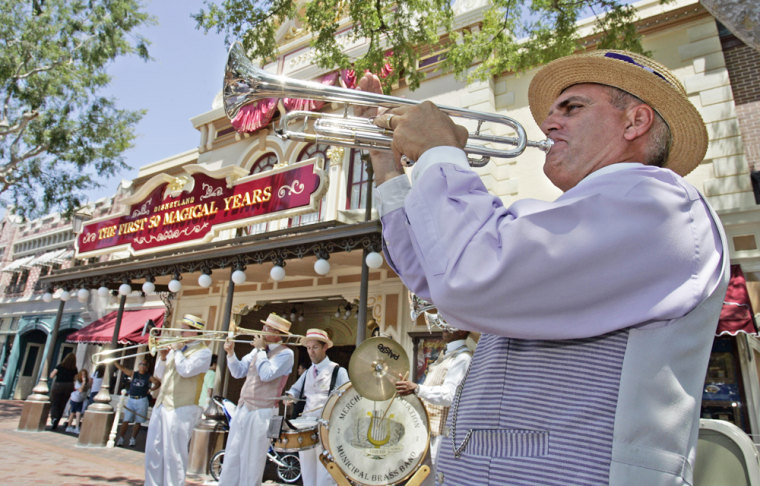Hey Disneyland, you’ve just celebrated your 50th anniversary. What are you going to do next?
As its prototype theme park hits the half-century mark Sunday, The Walt Disney Co. is facing some critical challenges.
One is geographic. The company is set to open its 11th park in Hong Kong in September and could soon announce plans for another in mainland China. How many more places in the world can support a massive new multi-day theme park?
Disney’s biggest challenge, however, could be keeping the attention and dollars of a generation raised on video games that demands more control over their entertainment than most Disney attractions provide.
“Almost everything Disney does today is passive while kids today expect everything to be interactive,” said Martin Lindstrom, a brand expert and author who has consulted for Disney and other companies such as Mattel Inc.
Disney is counting on the Internet, cell phones, digital projectors and other technology to make its parks more appealing to Gen-Y while maintaining the nostalgia that appeals to baby boomers.
“The problem is that they’re not doing it the full way, they’re doing it a little bit,” Lindstrom said. “If they don’t do it, five or six years from now they will have a major problem.”
Disneyland was wildly innovative when it opened on July 17, 1955. Founder Walt Disney used robotic figures, holographs and panoramic movies in circular theaters to spin stories for children. With virtually no competition, he had little trouble capturing the imagination of the world.
Over the years, Disney has pioneered new technology in rides such as “Mission Space” at Epcot in Orlando, Fla., and the revamped “Space Mountain” in Anaheim. But these days, the company finds itself competing against parks that feature taller, faster and scarier thrill rides.
“Disney is always going to address the competition, and the competition isn’t just other theme parks,” said Bill Coan, a former Disney employee who is now with Itec Entertainment, which designs theme park attractions.
“It’s video games, 120 channels of TV and shopping malls,” he said.
Disney’s parks and resorts division earned $193 million in operating profit during the second fiscal quarter, up 3 percent from the same quarter last year. Attendance at Disney’s domestic parks is beginning to approach pre-Sept. 11 levels, the company said when it released quarterly earnings in May.
Disney is already introducing innovations at its parks around the world. “Buzz Lightyear Astro Blasters” was recently unveiled at Disneyland. Riders turn circles in their cars while shooting laser cannons to defeat the evil Emperor Zurg.
They compete for points, but the interactivity doesn’t end there. People at home can download a free video game and play right along with the riders in real time.
One of the more ambitious interactive experiments is the “Virtual Magic Kingdom,” where players compete in cyberspace versions of Disney parks. They’re given tasks, like finding images of Mickey Mouse hidden in the architecture, then receive points to “purchase” hats, T-shirts or other items for their online personas.
Cell phones also figure to play a role in parks of the future. An adventure game, for instance, could require guests to take a particular picture with their camera phone to activate an animated clue.
“I look at this group as the audience that we’ve always wanted,” said Bruce Vaughn, vice president of research and development at Walt Disney Imagineering, which designs and builds theme parks and hotels.
“The more people want to be immersed and involved in the stories, the more opportunity there is for us to differentiate the theme park experience form any other sort of storytelling experience,” he said.
That approach will be critical as the company expands overseas. Disney is planning a park in mainland China, perhaps Shanghai, to take advantage of that country’s growing middle class.
It’s also contemplating smaller, more regional parks in places like South Korea, Singapore and Australia. Those sites wouldn’t necessarily be replicas of the “Magic Kingdom” but could be designed to appeal to local residents, said Jay Rasulo, president of Walt Disney Parks and Resorts.
“If it isn’t the big weeklong destination or multi-day destination, could it be a day destination for smaller markets and what would that product look like?” Rasulo said.
“I won’t say we’ve studied in depth any of those markets, yet we do find a great deal of Disney affinity,” he said. “I’m pretty optimistic that Asia — not only China but other places in Asia — are potential markets for us over the next 10 to 15 years.”
In places such as South Korea, where nearly 100 percent of the population has a high-speed Internet hookup, Disney would be compelled to emphasize interactive rides and attractions.
Analysts said there is a risk in moving too fast to attract tech-savvy kids at the expense of adults who recall more traditional park offerings with nostalgia.
Disney has always emphasized family entertainment, unlike some parks where parents drop off kids to enjoy thrill rides.
“There is always going to be a challenge to match up technology and gimmicks with good story,” Coan said. “They have to be careful not to isolate their entertainment and attractions to boys 8-18.”
